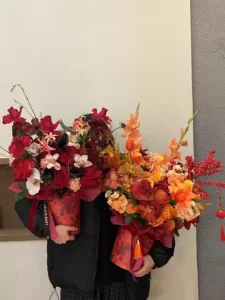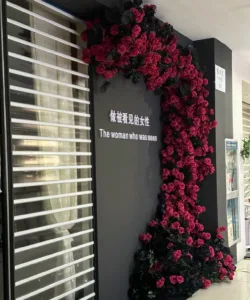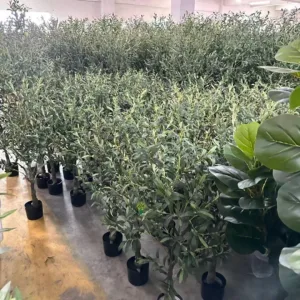China’s long history of craftsmanship has given birth to countless artistic innovations, and one of the most fascinating is the creation of artificial flowers. These flowers have been a significant part of Chinese culture for centuries, used in religious ceremonies, royal decorations, and eventually making their way into everyday life. Over time, China has become the global leader in the production of artificial flowers, supplying millions around the world. Today, artificial flowers made in China are widely recognized for their beauty, durability, and affordability.

In this blog, we will take a deep dive into the history of China’s artificial flowers, tracing their roots from the ancient world to the modern age. We’ll explore how these silk wonders became an industry powerhouse, serving global markets with lifelike flowers that meet both cultural and aesthetic demands. Whether you’re a wholesaler looking for a new product line or simply curious about the history, this guide will illuminate the fascinating journey of artificial flowers in China.

1.Early Beginnings: Ancient China’s Silk Flowers
The art of artificial flowers in China can be traced back to the Tang Dynasty (618–907 AD). It was during this era that silk flowers, also known as “hua,” became highly popular among the elite. These flowers were not just decorative; they carried deep symbolic meanings related to Chinese traditions, from honoring deities to celebrating life’s milestones such as weddings and festivals.
Crafting artificial flowers was a painstaking process, requiring skilled artisans to cut, dye, and shape silk into petals, which were then carefully assembled to mimic the appearance of real blooms. These silk flowers were primarily used in religious ceremonies and temple decorations, where real flowers were impractical due to their short lifespan. Silk, revered for its softness and brilliance, became the material of choice for these creations, symbolizing luxury and wealth.
During the Song Dynasty (960–1279 AD), artificial flowers gained further cultural importance. They were used in homes and formal gardens, symbolizing good fortune and prosperity. The artistry and symbolism behind these flowers reflected the growing importance of beauty and aesthetics in Chinese society.

2.The Evolution Through Dynasties
As China progressed through the Ming (1368–1644 AD) and Qing (1644–1912 AD) dynasties, the demand for artificial flowers increased significantly. What once was a luxury good for the aristocracy became more accessible to the common people. By the Qing dynasty, artificial flowers were being mass-produced, and the craft became a thriving industry.
The production methods evolved during this time as artisans began experimenting with new materials like paper, bamboo, and even metal to create more intricate designs. The flowers themselves became symbols of different seasons and festivals. For example, plum blossoms (a winter flower) symbolized perseverance and purity, while lotus flowers, with their association to Buddhism, symbolized spiritual enlightenment.
In addition, the Chinese New Year and other significant festivals saw homes and public spaces adorned with artificial flowers, symbolizing wishes for a prosperous year ahead. The rise of traditional Chinese operas and theater also contributed to the popularity of artificial flowers, as actors frequently wore elaborate headpieces decorated with them.

3.Modernization and Global Export
China artificial flower industry saw significant change with the rise of modern industrialization in the early 20th century. Before the advent of modern production techniques, most artificial flowers were handmade by skilled craftsmen. However, industrialization brought about mass production, allowing flowers to be manufactured on a much larger scale and exported around the world.
The development of machinery for cutting and assembling artificial flowers revolutionized the industry. During the mid-20th century, especially after China opened its markets, exports of artificial flowers surged. By the 1980s and 1990s, China had become the world’s largest exporter of artificial flowers. Factories in regions such as Guangdong and Zhejiang became hubs for artificial flower production, supplying large quantities to Europe, the Americas, and beyond.
China artificial flowers became favored globally for their competitive pricing and quality craftsmanship. What started as a cultural craft was now fueling an entire industry that catered to the growing global demand for realistic, long-lasting flowers.

4.Material Innovation in the 21st Century
With the onset of the 21st century, the artificial flower industry continued to evolve. One of the key factors driving this evolution was innovation in materials. No longer were artificial flowers limited to silk and paper; modern materials such as polyester, foam, and plastic were introduced, allowing for more durable and versatile designs.
Among these, polyester became the material of choice for most artificial flowers due to its ability to mimic the texture and sheen of real petals. Additionally, advancements in dye technology allowed for more vibrant and realistic colors. These innovations paved the way for hyper-realistic artificial flowers that looked and felt almost identical to their natural counterparts.
Today’s artificial flower industry in China is characterized by a fusion of traditional craftsmanship and modern technology. Factories are equipped with cutting-edge machinery that can produce flowers in vast quantities without sacrificing quality. The focus is on replicating nature as closely as possible, ensuring that the flowers meet international standards of beauty and realism.

5.The Role of China Artificial Flowers Industry in Today’s Market
Today, China remains the undisputed leader in the global artificial flower market. According to recent industry reports, over 70% of the world’s artificial flowers are produced in China. The reasons for China’s dominance in this industry are multifaceted: the country has a rich tradition of craftsmanship, a deep knowledge of artificial flower making, and access to a vast labor force and advanced manufacturing technologies.
In terms of global exports, China artificial flowers are highly sought after in the United States, Europe, Japan, and the Middle East. Their appeal lies in their affordability, variety, and ability to meet diverse consumer preferences. From hyper-realistic wedding bouquets to decorative centerpieces, Chinese artificial flowers cater to both individual consumers and large-scale wholesale markets.
In the wholesale market, distributors and retailers rely heavily on China’s vast supply chain to meet their customers’ needs. Chinese manufacturers are known for their fast turnaround times and capacity to produce customized designs. This level of adaptability has made China an ideal supplier for artificial flower wholesalers around the world.
For businesses looking to enter the artificial flower market or expand their current product offerings, sourcing from China is often the most economical and reliable option.

6.How to import artificial flowers from China?
As a distributor or wholesaler, sourcing artificial flowers from China can offer significant advantages in terms of price and variety. However, it’s crucial to find a reliable supplier that can meet your business’s specific needs. we have a blog expressly talk about the procress of import artificial flowers from China.
Here are a few tips for sourcing China artificial flowers:
• Assess the Scale of Your Business: If you’re a large-scale distributor, work with manufacturers who have the capacity to meet high-volume orders. For smaller businesses, explore partnerships with suppliers offering flexible minimum order quantities (MOQs).
• Visit Trade Shows: China hosts several trade shows focused on artificial flowers, such as the Canton Fair, where you can meet manufacturers and view their latest designs in person.
• Evaluate Supplier Credentials: Ensure that the suppliers you work with have the necessary certifications and quality control processes in place.
• Customization Options: Look for suppliers that offer customization to meet specific regional or market preferences.
At Plantifya, we offer a diverse selection of high-quality artificial flowers sourced directly from trusted manufacturers in China. With a wide range of designs and customization options, we provide reliable, fast, and affordable solutions for wholesalers worldwide.

Frequently Asked Questions of China artificial flowers
Where are most artificial flowers made?
Most artificial flowers in the world are made in China. China is the largest producer and exporter of artificial flowers globally。
Can I order artficial flowers in China?
of course, we can ship the goods from China by air for small order and by sea for bulk orders.
Who makes silk flowers in China?
There are so many manufacturers of silk flowers, our function is help you to get the realistic , high quality silk flowers with reasonable price.
What are the raw materials for making artificial flowers?
Common materials include plastic (PE, PP, PVC), polyester fabric, wire stems, foam (polyurethane/styrofoam), and silicone for high-end designs. Decorative elements like dyes, glitter, or beads are often added for realism.
Conclusion
The history of China artificial flowers is a testament to the country’s remarkable blend of tradition and innovation. From their origins in ancient Chinese royalty and temples to their global dominance in the 21st century, China’s artificial flowers have evolved into an essential product for markets around the world. Whether you’re a wholesaler or distributor, understanding the rich history behind these flowers can give you a deeper appreciation for their craftsmanship and enduring appeal.
At Plantifya, we’re proud to offer a vast collection of artificial flowers to meet the needs of businesses worldwide. Explore our catalog today and discover why Chinese artificial flowers continue to bloom in popularity across global markets.
Visit Plantifya to browse our latest artificial flower collections and contact us to place your wholesale order today.





